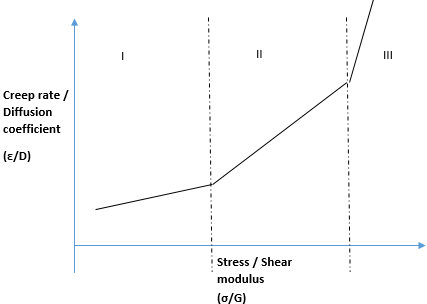This set of Mechanical Metallurgy Multiple Choice Questions & Answers (MCQs) focuses on “Creep & Stress Rupture – Creep Deformation Mechanism – 1”.
1. In a material, if several mechanisms are operating in parallel to creep the material, then the creep rate will be decided by the __________
a) slowest operating mechanism
b) fastest operating mechanism
c) sum of creep rate of all the mechanisms
d) multiplication of creep rate of all the mechanisms
View Answer
Explanation: In a material, if several mechanism are operating in parallel then the fastest operating mechanism decides the creep rate of the material.
2. In a material, if several mechanisms are operating in series to creep the material, then the creep rate will be decided by the __________
a) slowest operating mechanism
b) fastest operating mechanism
c) sum of creep rate of all the mechanisms
d) multiplication of creep rate of all the mechanisms
View Answer
Explanation: In a material, if several mechanisms are operating in sequence, then the slowest operating mechanism decides the creep rate of the material.
3. In the dislocation creep mechanism of the creep, the rate-controlling step is ____________
a) rate of recovery
b) rate strain hardening
c) atomic diffusion
d) dislocation glide
View Answer
Explanation: The dislocation creep is the movement of dislocation at high temperature. It is done in two-steps. First, the glide of dislocation on plane and second, when any obstacle comes, the dislocation climbs and moves to parallel or another plane. Hence, the climb is controlled by diffusion of atoms and diffusion is a slow process; hence, the diffusion of atoms becomes the rate-controlling step.
4. The power-law relation is used to describe the ____________
a) creep elongation
b) creep mechanism
c) creep rate
d) fracture behavior
View Answer
Explanation: The power law relation is used at intermediate to high temperature at the higher stress levels. And the creep rate is determining by power-law relation.
5. The power-law relation is used for which type of creep mechanism?
a) Dislocation glide
b) Dislocation creep
c) Diffusional Creep
d) Grain boundary sliding
View Answer
Explanation: The power-law relationship is used to describe the diffusional creep mechanism of the material. This law allows us to use the equation at both the higher temperature and lower temperature.
6. Which equation describes the power law of creep?
a) εs = Bσn exp(-Q/RT)
b) εs = σn exp(-Q/RT)
c) εs = exp(-Q/RT)
d) εs = Bσn
View Answer
Explanation: This law combines the effect of the diffusion coefficient on the diffusion of atom in creep state along with the values of the applied stress. Hence, it determines the creep rate of the material.
7. At higher temperature, the lattice diffusion is predominant whereas at lower temperature diffusion along the dislocation core is predominant.
a) True
b) False
View Answer
Explanation: At higher temperature, the diffusion coefficient of the atoms is high, so the lattice diffusion is easy to take place. As the temperature reduces, the diffusion along the lattice becomes difficult and it chooses the more comfortable path which is along the dislocation core.
8. The Sellars-Tegart equation of creep rate determination is used during __________
a) very high stress
b) very temperature
c) low stress and low temperature
d) low stress and high temperature
View Answer
Explanation: At very high stress, the power-law breaks down, and the measured creep rate is greater than predicted, so the Sellars-Tegart equation is used to calculated the creep rate.
9. The below curve represents the relation between the normalized creep rate with normalized stress. In which of the following region the power law is valid?

a) I
b) II
c) III
d) Any
View Answer
Explanation: The power law is valid at intermediate stress range with higher acceptable temperature limit, so the middle region II indicates the region where the power-law is correct.
10. The following curve represents the relation between the normalized creep rate with normalized stress. In which of the the region, the Harper-Dorn Creep law is valid?

a) I
b) II
c) III
d) Any
View Answer
Explanation: The Harper-Dorn creep law is valid at lower stress range with lower acceptable temperature limit, so the first region indicates the region where the Harper-Dorn law is correct.
Sanfoundry Global Education & Learning Series – Mechanical Metallurgy.
To practice all areas of Mechanical Metallurgy, here is complete set of 1000+ Multiple Choice Questions and Answers.
If you find a mistake in question / option / answer, kindly take a screenshot and email to [email protected]
- Check Metallurgical Engineering Books
- Check Mechanical Metallurgy Books
- Practice Metallurgical Engineering MCQs
- Apply for Metallurgical Engineering Internship
